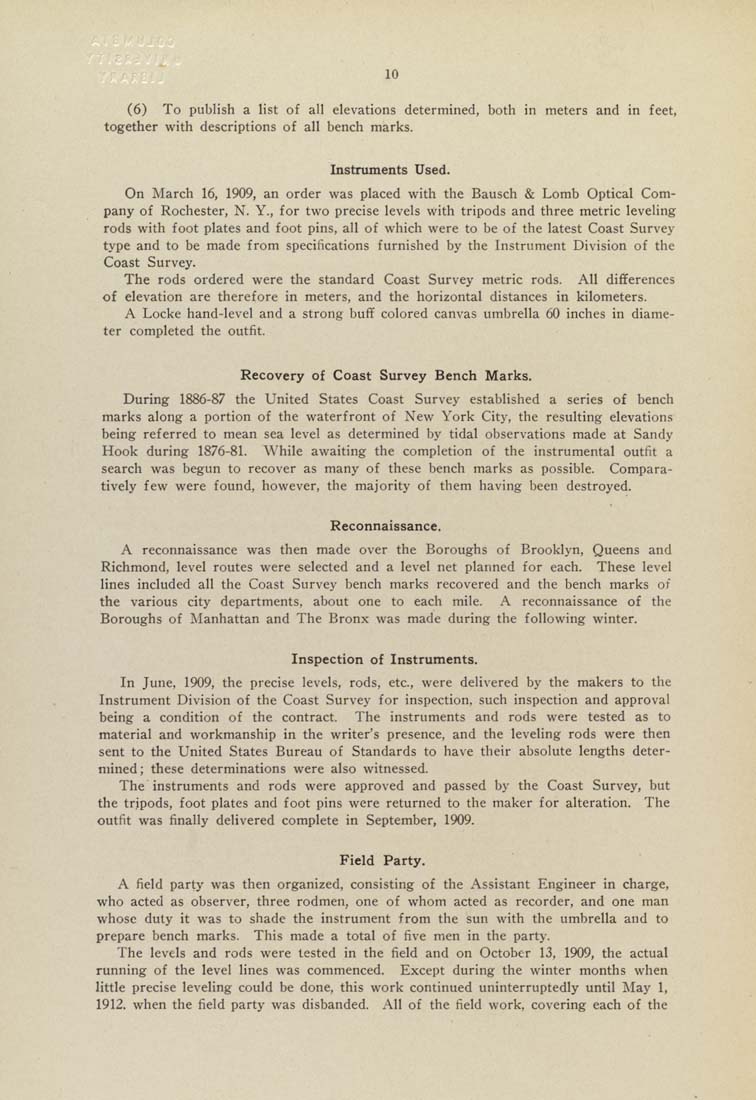(6) To publish a list of all elevations determined, both in meters and in feet,
together with descriptions of all bench marks.
Instruments Used.
On March 16, 1909, an order was placed with the Bausch & Lomb Optical Com¬
pany of Rochester, N. Y., for two precise levels with tripods and three metric leveling
rods with foot plates and foot pins, all of which were to be of the latest Coast Survey
type and to be made from specifications furnished by the Instrument Division of the
Coast Survey.
The rods ordered were the standard Coast Survey metric rods. All differences
of elevation are therefore in meters, and the horizontal distances in kilometers.
A Locke hand-level and a strong buff colored canvas umbrella 60 inches in diame¬
ter completed the outfit.
Recovery of Coast Survey Bench Marks.
During 1886-87 the United States Coast Survey established a series of bench
marks along a portion of the waterfront of New York City, the resulting elevations
being referred to mean sea level as determined by tidal observations made at Sandy
Hook during 1876-81. While awaiting the completion of the instrumental outfit a
search was begun to recover as many of these bench marks as possible. Compara¬
tively few were found, however, the majority of them having been destroyed.
Reconnaissance.
A reconnaissance was then made over the Boroughs of Brooklyn, Queens and
Richmond, level routes were selected and a level net planned for each. These level
lines included all the Coast Survey bench marks recovered and the bench marks of
the various city departments, about one to each mile. A reconnaissance of the
Boroughs of Manhattan and The Bronx was made during the following winter.
Inspection of Instruments.
In June, 1909, the precise levels, rods, etc., were delivered by the makers to llie
Instrument Division of the Coast Survey for inspection, such inspection and approval
being a condition of the contract. The instruments and rods were tested as to
material and workmanship in the writer's presence, and the leveling rods were then
sent to the United States Bureau of Standards to have their absolute lengths deter¬
mined; these determinations were also witnessed.
The instruments and rods were approved and passed by the Coast Survey, but
the tripods, foot plates and foot pins were returned to the maker for alteration. The
outfit was finally delivered complete in September, 1909.
Field Party.
A field party was then organized, consisting of the Assistant Engineer in charge,
who acted as observer, three rodmen, one of whom acted as recorder, and one man
whose duly it was to shade the instrument from the sun with the umbrella and to
prepare bench marks. This made a total of five men in tiie party.
The levels and rods were tested in the field and on October 13, 1909, the actual
running of the level lines was commenced. Except during the winter months when
little precise levehng could be done, this work continued uninterruptedly until May 1,
1912. when the field party was disbanded. All of the field work, covering each of the
|








